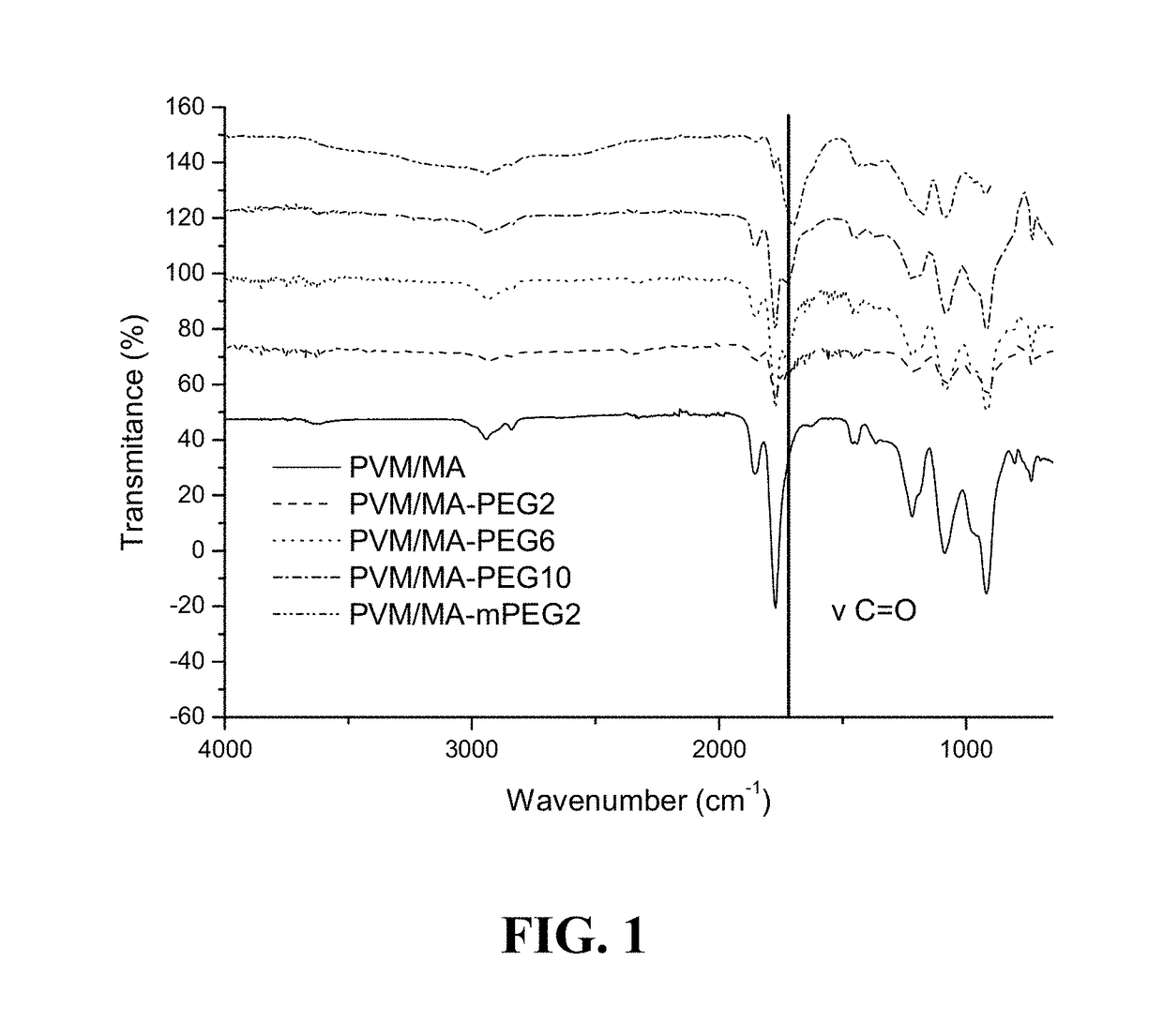Nanoparticles for encapsulating compounds, the preparation and uses thereof
- Summary
- Abstract
- Description
- Claims
- Application Information
AI Technical Summary
Benefits of technology
Problems solved by technology
Method used
Image
Examples
example 1
Preparation of Conventional PVM / MA Nanoparticles
Preparation of Empty Conventional PVM / MA Nanoparticles (NP)
[0199]100 mg PVM / MA were dissolved in 5 mL of acetone and nanoparticles were formed by the addition of a mixture of ethanol and water (1:1, v / v). Then, organic solvents were eliminated by evaporation under reduced pressure and the resulting suspension was filtered through a 0.45 μm membrane and purified twice by centrifugation 27,000×g for 20 min. The supernatant was removed and the pellet resuspended in water. Finally, the formulation was frozen and freeze-dried (Genesis 12EL, Virtis, USA) using sucrose (5% w / w) as cryoprotector. These are empty nanoparticles of PVM / MA, hereinafter NP formulations (NP).
Preparation of Conventional PVM / MA Nanoparticles Encapsulating Paclitaxel (PTX)
[0200]Paclitaxel-loaded PVM / MA nanoparticles were prepared by a solvent displacement method with some modifications. Briefly, 10 mg of paclitaxel were dispersed in 5 mL of acetone containing 100 mg of...
example 2
Preparation of Traditional Pegylated PVM / MA Nanoparticles
Preparation of Empty Traditional Pegylated PVM / MA Nanoparticles (PEG Trad)
[0203]Pegylated PVM / MA nanoparticles were prepared by a solvent displacement method. Briefly, 12.5 mg of polyethyleneglycol (PEG2, PEG6 or PEG10) were dissolved in 3 mL of acetone and, then, added to a solution of 100 mg of PVM / MA in 2 mL of the same organic solvent. The resulting mixture was maintained under magnetic agitation for 1 h at room temperature. Then, nanoparticles were formed by the addition of 10 mL of ethanol followed by the addition of 10 mL of water. The organic solvents were removed by evaporation under reduced pressure (Büchi R-144, Switzerland) and the resulting suspensions purified by tangential filtration in Vivaspin tubes at 3000×g for 20 min. The supernatants were removed and the pellets resuspended in water. The purification process was repeated twice and finally, the formulations were frozen and freeze-dried (Genesis 12EL, Virtis...
example 3
Preparation and Characterization of Ester Polymer Conjugates of PVM / MA
3.1 Preparation of Ester Polymer Conjugates of PVM / MA
[0207]In this case, polyethyleneglycols of different molecular weights 2,000, 6,000 or 10,000 and methoxy-polyethylene glycol 2000 were tested.
[0208]To prepare the ester polymer conjugates, 5 g of PVM / MA were dissolved in 250 ml of an organic solvent (i.e. acetone) and incubated with different amounts of polyethyleneglycol or derivative thereof for 3 h under magnetic stirring at 50° C. The hydroxyl-terminated molecule:(PVM / MA) ratios tested were:[0209]mPEG:(PVM / MA) 1:5; for mPEG2[0210]PEG: (PVM / MA) 1:20; 1:8; for PEG2, PEG6 and PEG10
[0211]After incubation, the solvent was removed and the resulting ester polymer conjugate was dried by reduced pressure evaporation (Büchi R210, Switzerland). Finally, the dried ester polymer conjugates obtained were purified by washing with dichloromethane (CH2Cl2) and filtering under vacuum (all-glass filter, Merck Millipore, Germa...
PUM
| Property | Measurement | Unit |
|---|---|---|
| Fraction | aaaaa | aaaaa |
| Fraction | aaaaa | aaaaa |
| Fraction | aaaaa | aaaaa |
Abstract
Description
Claims
Application Information
 Login to View More
Login to View More - R&D
- Intellectual Property
- Life Sciences
- Materials
- Tech Scout
- Unparalleled Data Quality
- Higher Quality Content
- 60% Fewer Hallucinations
Browse by: Latest US Patents, China's latest patents, Technical Efficacy Thesaurus, Application Domain, Technology Topic, Popular Technical Reports.
© 2025 PatSnap. All rights reserved.Legal|Privacy policy|Modern Slavery Act Transparency Statement|Sitemap|About US| Contact US: help@patsnap.com



